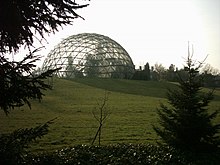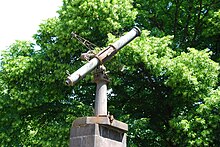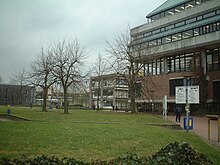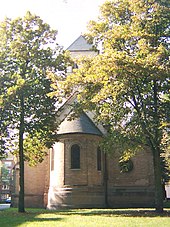Bilk
|
Bilk district of the state capital Düsseldorf |
|||
|---|---|---|---|
|
|
|||
| Basic data | |||
| Geographic location : | 51 ° 12 ' N , 6 ° 47' E | ||
| Height: | 40 m above sea level | ||
| Surface: | 6.07 km² | ||
| Residents: | 40,038 (December 31, 2016) | ||
| Population density : | 6,596 inhabitants per km² | ||
| Incorporation : | 1384 | ||
| District: | District 3 | ||
| District number: | 036 | ||
| Transport links | |||
| Autobahn : |
|
||
| Bundesstrasse : |
|
||
| S-Bahn : | S 1 S 6 S 8 S 11 P 28 P 68 | ||
| Light rail : | U 71 U 72 U 73 U 79 U 83 | ||
| Tram : | 701 704 706 709 | ||
| Express bus: | SB 50 SB 56 SB 57 | ||
| Bus route: | 723 726 727 731 735 736 780 782 785 827 835 836 893 | ||
| Night traffic: | NE 6 NE 7 NE 8 | ||
Bilk is a district of the North Rhine-Westphalian state capital Düsseldorf . The area of the formerly independent town was incorporated into Düsseldorf as early as 1384 and, in addition to the current Bilk district, also included the current districts of Oberbilk , Unterbilk and Friedrichstadt . Bilk belongs to district 3 and is the most populous district of the city with around 40,000 inhabitants on an area of 6.07 km².
Geography and population
location
In the north, the district boundary runs immediately south of the Düsseldorf – Neuss railway line ; Bilk borders on the neighboring districts of Unterbilk and Friedrichstadt . To the east of Bilk are the districts of Oberbilk and Wersten . The district boundary to Oberbilk runs immediately east of the Düsseldorf – Cologne railway line and then follows the Moritz-Sommer-Straße and the Bittweg (both in the middle of the street) to the south. The border to Wersten runs along Werstener Straße , the east bank of a former quarry pond and the Brückerbach . Bilk encloses the area of Flehe along Münchener Strasse, Himmelgeister Strasse (southern part), Ulenbergstrasse, Aachener Strasse and Volmerswerther Strasse . Also in the south, the district borders the fields of Volmerswerth along the southern edge of the Südfriedhof . The fields of Hamm connect to the west . The border here runs parallel to the western edge of the Südfriedhof and further north along Völklinger Straße .
Use and development
Closed construction is predominant in a 300–600 meter wide strip south of the Düsseldorf – Neuss railway line . The northern part of Bilk is therefore particularly densely populated. There are also more shops and businesses here than in the rest of the district. This part is also traversed by the southern Düssel , which is often led through tunnels here, in an east-west direction. The mostly loosely built-up south contains several green spaces with the south cemetery , the park at the former observatory , the Ulenbergstrasse leisure park and the botanical garden . The Heinrich Heine University , whose campus and clinic is located in the southeast of the district, is currently the most formative factor in Bilk. Many students and university employees live not only in the dormitories on campus and north of the clinic premises, but also in the rest of the district. At least in Bilk, there is a generally rather weak student pub culture in Düsseldorf.
history
“In documents from 1395, both Oberbilk and Arenbilk are mentioned, but never Unterbilk. Only after the construction of the Bilker train station did the name "Unterbilk" suddenly appear on a map from 1891 in fine flourishes. A city official had created a new district on paper. [...] But friends of home and planners know: "The Unterbilkers feel like Bilkers". "
Against this background, it is not possible to differentiate between the Bilker and Unterbilker history and often also between the sense of home of the Bilker and Unterbilker, so that the district history outlined below encompasses more than what has happened within today's Bilker borders.
middle Ages
As finds from two burial grounds show, Bilk was settled in the early Middle Ages (6th / 7th centuries). Both sites are, however, quite far away from the later town center near Alt St. Martin . Bilk was first mentioned in writing on February 14, 799 as an estate (villa Bilici) , probably a royal estate with a church. The small tuff stone church Alt St. Martin on the southern branch of the Düssel was perhaps built around 700. However, it was first mentioned in a document in 1019. In a listing of the properties of Deutz Abbey from 1147, Pope Eugene III confirmed. among many others on the Lower Rhine for the greater Düsseldorf area, property in "Bilka" and "Castrum Burgela" ( Haus Bürgel ).
In a list of the possessions of the Gerresheim Abbey from 1218, three sub-courtyards in Bilk were listed for the main courtyard (Villae) Dern in addition to 62 other courtyards in today's greater Düsseldorf area. Around 1250, the Gerresheim honors in Bilk must also have owned property rights. In a document from 1273 these were reduced to a separate area by the entire Bilker Gemark. This document was testified by the noblemen “Theodorico and Henrico de Elner” and “Wernero de Horst”, among others. The noble family of the "Ritter von Horst" owned the Bilker Mark in the 13th century. In 1290, knight Heinrich von Horst gave Heinrich von Windeck , a member of the Count von Berg family, his court in Bilk as a fief for 50 marks.
Until 1206 the fishing village "dusseldorp", the village on the Düssel, located on a northern branch of the Düssel and first mentioned in 1159 belonged to the parish of Alt St. Martin in Bilk. In that year a chapel in the old town of Düsseldorf was elevated to a parish church and its own parish was formed. On August 14, 1288, after the Battle of Worringen , Duesseldorf was granted city rights by Count Adolf V von Berg and the parish church became a collegiate church. The county was elevated to a duchy in 1380 and the palace in Düsseldorf became the seat of government of the new dukes. When Düsseldorf was expanded at the end of March 1384, in addition to the honors of Golzheim and Derendorf , the large village of Bilk was also assigned to the city of Düsseldorf.
The “urban freedoms” that were promised during the incorporation were restricted in a further document. In this document of April 4, 1384, the bilkers only received all “urban freedoms” if they also had an apartment in the city.
At that time Bilk consisted of the three honors: Arienbilk, or Orienbilk, today's Oberbilk, Muhlhoven, about the current Unterbilk, and Kirchbilk with St. Martin, the core of today's Bilk district. These three honors Bilk already had their own jury before they were incorporated in Düsseldorf. This Bilker court was dissolved in 1394 by Duke Wilhelm von Berg and replaced by the Düsseldorf court.
Modern times
The large village of Bilk consisted of a number of courtyards and houses along the southern Düssel in the course of today's Suitbertusstrasse and Martinstrasse to the new Bilk Church of St. Martin, which stands on the site of the Loreto Chapel built in 1686 . Bilk was divided into three districts: Kirchbilk (Alt St. Martin), Mühlenhofen and Arenbilk (Oberbilk). Larger courtyards are known by name: Burghof, Deuzerhof, Fechelshof or Rheindorfer Hof.
From 1852 onwards, an important metal and iron industry was established in Oberbilk , southeast of Düsseldorf . In 1854 the Prussian King Friedrich Wilhelm IV approved a necessary expansion of the city, which connected Bilk with Düsseldorf to the south via today's Friedrichstadt . Due to the relocation of rail traffic to the Düsseldorf main train station , which opened in 1891 at its current location, the railway line that had existed since 1870 after the completion of the Hammer Railway Bridge had to be relocated from Düsseldorf over the Rhine to Neuss and led through Bilk. The district was cut up in this way, but also received its own train station . The northern part became Unterbilk , the southern part kept the name Bilk . The old railway line from the old Düsseldorf train station near today's Graf-Adolf-Platz along the current media port to the Hammer railway bridge was abandoned.
Bilk has also become known in astronomy through the Düsseldorf observatory . In 1843 Johann Friedrich Benzenberg (1777–1846) set up the private Charlottenruhe observatory in Bilk near Alt St. Martin and carried out sky observations there. After his death, the city of Düsseldorf took over the observatory. Between 1852 and 1890 the successor Benz mountain, the astronomer discovered here Robert Luther (1822-1900), 24 planetoids and asteroids (of Thetis on 17 April 1852 to Glauce on 20 February 1890), as the 24 Düsseldorf planet known were. In 1943 the Düsseldorf observatory was destroyed in a bomb attack. The annealed body of the telescope of the observatory stands today as a reminder in front of the west tower of Alt St. Martin. If you look through the pipe, you can see the rooster on the church tower.
On the Lausward (Lauswerth) Rhine peninsula west of Unterbilk, Düsseldorf's first horse racing track was opened in 1876. The new urban port was built here from 1890 to 1896. In 1955, the construction of the Lausward power station began. The eastern part of the Düsseldorf harbor , which is close to the city , has developed into the focus of various telecommunications companies and advertising agencies since 1990 and is therefore also called the media harbor . The telecommunications tower was completed there in 1982 , the new building of the North Rhine-Westphalia state parliament in 1988 , the WDR radio station in Düsseldorf and the Neue Zollhof in 1999 by the well-known contemporary architect Frank O. Gehry . 1996 on the south end of the media was close to the port rheinufer tunnel standing Düsseldorf gate with its double façade opened and a dynamic cooling system.
At the same time as the construction of the municipal hospitals south of Moorenstrasse between Witzelstrasse and Himmelgeister Strasse in Stoffeln in 1907, the Düsseldorf Academy for Practical Medicine , from which the University of Düsseldorf emerged in 1965 , was founded. The university campus, which also includes the Botanical Garden , which opened in 1974, grew south of the hospital grounds . In 1973 the municipal hospitals in Bilk became the responsibility of the state of North Rhine-Westphalia and were renamed the Düsseldorf University Hospital .
Famous pepole
- The politician and lawyer Jakob Salentin von Zuccalmaglio (1775–1838) was born in Bilk.
- The pastor of St. Martin, Anton Joseph Binterim (1779–1855), was a Roman Catholic clergyman , theologian and church historian as well as a member of the Prussian National Assembly from 1848
- Ferdinand Freiligrath (1810–1876) lived in 1850/51 at Neusser Straße 133, opposite the Loreto Chapel (today opposite the Bilker Church in Unterbilk).
- Ferdinand Lassalle (1825–1864) lived temporarily in 1856/57 in the house of Countess Sophie von Hatzfeldt (1805–1881) at Friedrichstrasse 53, today Unterbilk.
- The writers Heinrich Spoerl (1887–1955) and son Alexander Spoerl (1917–1978) went to school in the Ober-Real-Schule at Fürstenwall 100 (today Albrecht Dürer School) in Unterbilk. The novels Die Feuerzangenbowle (1933) by Heinrich Spoerl and Memoirs of a Mediocre Student (1950) by Alexander Spoerl emerged from these experiences .
- The musician Jürgen Engler was born in Bilk in 1960.
- The chef and businessman Ralf Bos was born in Bilk in 1961.
- The writer Sabine Klewe lives in Bilk.
Transport and other infrastructure
Private transport
In a west-east direction over the Südring, Kopernikusstraße and Auf'm Hennekamp, the so-called Düsseldorfer Lastring runs through Bilk. The district areas north of it are in the environmental zone . In the south is the A 46 motorway , which disappears in a tunnel between the clinic grounds and the rest of the university campus . To the west of this tunnel, the district is connected to the motorway via the Düsseldorf-Bilk junction. Several thoroughfares run through Bilk in a north-south direction and take motor traffic in and out of town. In the west, Bundesstraße 1 touches the district via Völklinger Straße. Via the northern Merowingerstraße and further along the Münchener Straße - a multi-lane road that was completed in the early 1990s to relieve some of the Bilker and Fleher residential areas - through traffic crosses Bilk to and from the university, Benrath and Garath . Finally, the city center is connected to the A 46 motorway in the direction of Hilden and Wuppertal via Erasmusstraße, Mecumstraße, Witzelstraße and Werstener Straße . Mecumstraße and Erasmusstraße are among the busiest streets in Düsseldorf and have often hit the headlines in the past due to exceeding the fine dust limit values.
Transportation
The Bilk train station is located on the suburb of the Unterbilk area. Bilk train station is the stop of the S 8, S 11 and S 28 S-Bahn lines as well as several light rail lines (U 71, U 72, U 73, U 83) and bus lines (SB56, M3, 835, 836 and NE 7). Other stops on the S-Bahn lines S 8, S 11 and S 28 directly on the suburb of Bilk are Völklinger Straße and Friedrichstadt . With the completion of the Wehrhahn line and its extension to the local train station, the station was in addition to the breakpoint in the rail network , previously drove here the tram lines 703, 713, 706, 707, 708 and 712. The S-Bahn Volksgarten is stop the S- Train lines S 1, S 6 and S 68 as well as tram line 706.
Other tram lines (701 and 704) and bus lines (SB 50, 723, 726, 735, 780, 782, 785, 827, 893, M3, NE 8 and 809) operate in the rest of the district. Since August 30, 2010, the university campus in Bilk has been connected to the light rail network with the extension of the U 79 tram line to the Universität Ost / Botanischer Garten station, and since February 2016 also the U 73 line Metrobus lines M1, M2 and M3 throughout the city. The line M3 represents the connection to Düsseldorf-Bilk.
retail trade
Shops with several shops are located
- on Aachener Strasse between Suitbertusstrasse and Kopernikusstrasse
- on Himmelgeister Straße between Am Steinberg and Ulenbergstraße
- at Karolingerplatz and
- at Aachener Platz.
The Aachener Platz flea market is one of the largest flea markets in Germany. It has been held every Saturday since 1976 on Bilker Schützenplatz on Ulenbergstrasse.
Schools and colleges

There are four primary schools and one secondary school in Bilk. The vocational schools on Suitbertusstrasse and the school center between Brinckmannstrasse and Redinghovenstrasse with the Geschwister-Scholl-Gymnasium , the Hulda-Pankok -Gesamtschule and the Heinrich-Hertz-Berufskolleg are important throughout the city .
In addition to the teaching and research facilities of all faculties of Heinrich Heine University , the social and cultural sciences and economics departments of the Düsseldorf University of Applied Sciences are located on the campus in Bilk . The outdoor area and the greenhouses - especially the striking dome building - of the university's botanical garden are worth seeing .
societies
The St. Sebastianus Schützenverein Düsseldorf-Bilk eV 1475 , with around 900 active members, is the second largest rifle club in Düsseldorf. He organizes the joint rifle festival of the Bilk and Unterbilk districts with the fair on Schützenplatz on Ulenbergstrasse not far from Aachener Platz.
The Heimatverein Bilker Heimatfreunde eV maintains the Hermann Smeets archive in Jadehüske , Himmelgeister Straße 73, with collections on Ferdinand Freiligrath , Hermann Harry Schmitz and the Bilker observatory.
The three oldest sports clubs in and around Bilk, which also offer several sports, are the
- Friedrichstadt gymnastics club v. 1880 eV Düsseldorf,
- DJK TuSA 06 eV Düsseldorf and
- SV Grün-Weiß-Rot 1930 eV Düsseldorf
Sports facilities
The sports fields of DJK TuSA and SV Grün-Weiß-Rot are located south of the Ulenbergstrasse leisure park in Flehe . The sports center of the Heinrich Heine University with a soccer field, tennis courts, athletics track and two sports halls is located on campus . There is an indoor swimming pool in the Düsseldorf Arcaden .
Attractions
The Alt St. Martin Church on Martinstrasse is the oldest still visible architectural monument in Düsseldorf. The small tuff stone church on the southern arm of the Düssel is also called the Old Bilker Church and was built around 700 as a foundation by St. Suitbertus on the site of a pagan Germanic shrine. It can be proven as a hall church that was destroyed by fire by 900 at the latest. The church building St. Martin was first mentioned in 1019. The three-aisled Romanesque “miniature” pillar basilica is around 11 meters wide and 20 meters long inside. The central nave and the five-storey west tower are the oldest parts of the church and essentially date from the second half of the 12th century. After 1200 the church was expanded to include the choir with apse to the east. With the rebuilding of the side aisles, further changes were made in the 15th and 17th centuries. Inside, Romanesque ceiling paintings, which were created around 1245, have been preserved. The entrance portal is designed by the Düsseldorf artist Bert Gerresheim and depicts the deeds of the church patron Martin von Tours . The door handles show St. Bishop Hilarius of Poitiers , who ordained Martin priest, and the scholar Sulpicius Severus , who wrote the biography of St. Martin around 395.
literature
- Udohaben (ed.): Düsseldorf on foot, 17 city tours through the past and present . 1st edition, VSA-Verlag, Hamburg 1989
- Karl Endmann: Düsseldorf and its railways in the past and present . 2nd edition, Motorbuch Verlag, Stuttgart 1987
- Oswald Gerhard and Wilhelm Kleeblatt (eds.): Düsseldorfer legends from town and country . Faithful new edition from 1926, Verlag der Goethe-Buchhandlung, Düsseldorf 1982
- Karl Emerich Krämer : Through the Düsseltal to Düsseldorf . 1st edition, Mercator-Verlag Gert Wohlfahrt, Duisburg / Munich 1968
- Sonja Schürmann: Düsseldorf, a modern state capital with 700 years of history and culture . 1st edition, DuMont art travel guide, Cologne 1988
- Hermann Smeets: Villa Bilici. Düsseldorf-Bilk then and now . 1st edition, published by Stadt-Sparkasse Düsseldorf, Triltsch Druck und Verlag, Düsseldorf 1983
- Hugo Weidenhaupt: A Brief History of the City of Düsseldorf . 4th edition, Verlag L. Schwann, Düsseldorf 1968
Web links
Individual evidence
- ^ Office for statistics and elections of the state capital Düsseldorf: Statistics for the district 036 - Bilk
- ↑ OpenStreetMap / Relation / Bilk (92374) . Retrieved August 6, 2009.
- ^ State capital Düsseldorf: History of the city district 3 - From the vegetable suburb to the government district . Retrieved August 13, 2009.
- ^ Frank Siegmund: Merovingian time on the Lower Rhine. Rhenish excavations 34. Rheinland-Verlag, Cologne 1989, pp. 276–278
- ↑ According to others, the document refers to Bilk in the parish Wettringen (Münsterland) ; see. Henning Kaufmann : Are there ācum names on the right bank of the Rhine in the Rhineland? In: Rheinische Vierteljahrsblätter 38 (1974), pp. 32–53, especially pp. 35f.
- ↑ Cf. Theodor Joseph Lacomblet (arrangement): Document book for the history of the Lower Rhine , vol. I. Wolf, Düsseldorf 1840, no. 12, p. 8 ( Google Books ); Wilhelm Crecelius : Traditiones Werdensis , Part I. In: Zeitschrift des Bergisches Geschichtsverein 6 (1869), pp. 1-68, especially p. 11 ( Google Books ).
- ^ Hugo Weidenhaupt : Little history of the city of Düsseldorf , Triltsch-Verlag, Düsseldorf 1979, ISBN 3-7998-0000-X , p. 16
- ↑ Theodor Joseph Lacomblet, in: Urkundenbuch für die Geschichte des Niederrheins or the Erzstiftes Cöln, Urkunde 356 , 1840, Volume 1, 779–1200, p. [260] 244. Online version
- ^ Fahne, Anton, in: Die Fahnenburg and their picture gallery, chapter Stift Gerresheim , 1873, p. [26] 16. Online version
- ^ Theodor Joseph Lacomblet, in: Document book for the history of the Lower Rhine and the Archbishopric of Cöln, document 649 , 1840, part 2, 1201-1300, p. [417] 379. Online edition 2009 [1]
- ↑ Lacomblet, Theodor Joseph, in: Document book for the history of the Lower Rhine or the Archbishopric of Cologne, certificate no. 904 , 1846, volume 2, p. [576] 538. Digitized edition ULB Bonn
- ^ Theodor Joseph Lacomblet, in: Document book for the history of the Lower Rhine and the Archbishopric of Cöln, document 878 , 1853, part 3, 1301–1400, p. [783] 771.
- ^ Theodor Joseph Lacomblet, in: Document book for the history of the Lower Rhine and the Archbishopric of Cöln, document 880 , 1853, part 3, 1301–1400, p. [785] 773.
- ^ Digitized edition of the ULB Düsseldorf Düsseldorfer Geschichtsverein: Part 3, H. Eschenbach, in chapter: On the constitutional history of the city of Düsseldorf , p. [69] 52.
- ^ Theodor Joseph Lacomblet, in: Document book for the history of the Lower Rhine and the Archbishopric of Cöln, Certificate 1001 , 1853, Part 3, 1301–1400, p. [899] 887.
- ↑ Sale of the Deuzerhof in Bilk - on Tuesday, April 20, 1841 and on the following day, the so-called Deuzerhof in the community of Unterbilk, along with the associated communities of Unterbilk, Stoffeln and Flehe, just as the Bilker and Hammerfelde parcels are sold. (The sellers were primarily family members with the name Kux) , in Düsseldorfer Zeitung (No. 45), supplement dated February 14, 1841
- ^ City archive of the state capital Düsseldorf: A brief history of the city of Düsseldorf - The main train station . Retrieved August 13, 2009.
- ↑ Information on the Wehrhahn Line
- ^ Schützen-Bilk - about the Bilker Schützen . Archived from the original on March 24, 2011. Retrieved on August 7, 2009.
- ↑ bilkinfo - district pages Dusseldorf-Bilk - sports clubs . Retrieved August 7, 2009.
- ^ Website of the Friedrichstädter Turnverein v. 1880 eV Düsseldorf . Archived from the original on September 25, 2009. Retrieved on August 7, 2009.
- ^ Website of the DJK TuSA 06 eV . Retrieved August 7, 2009.
- ^ Website of the sports club Grün-Weiß-Rot 1930 eV . Retrieved July 25, 2011.
Remarks
- ↑ The rights listed for the Gerresheim honors presumably also originally belonged to the monastery and had been sold to the monastery at an earlier point in time.








